Reading your water meter is the important first step that we take to calculate and issue your quarterly bill.
The day our meter readers take a reading of your meter marks the end of one billing period and the start of the next.
The 4 steps below show how we issue your bill every quarter:
Step 1: Reading your water meter
Unitywater engages contractors to read your water meter. They carry identification cards and wear high-visibility uniforms.
We read your meter every three months (quarterly), then send your bill a few days later. To ensure that we bill you correctly, please make it easy for our meter readers to access your meter by clearing any overgrown grass, shrubs or other obstructions.
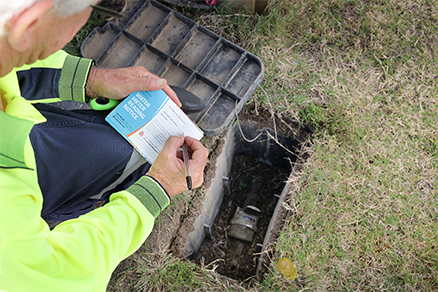
Step 2: Leaving a reading notice
We leave a Water Meter Reading Notice (PDF) in your letterbox that shows the date it was read and the meter reading. We use the black numbers on your water meter (kilolitres only) when taking the reading, and the meter reader writes this number on the notice.
We recommend you read your water meter to confirm the reading printed on the notice and on your next bill. If they are not the same, please contact us.
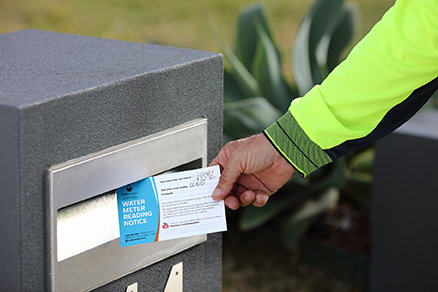
Step 3: Doing an in-house check
Your meter reading is put through a strict in-field and in-house audit to check it against your previous meter readings. If the reading seems too high or too low, compared with previous readings, we may reschedule a second reading to double check it is correct.
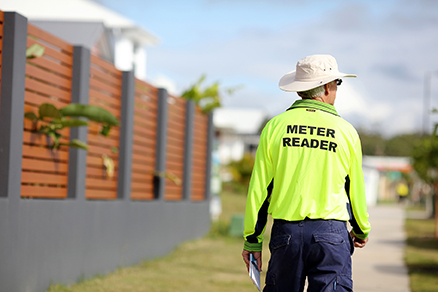
Step 4: Calculating your water usage
Your water usage is calculated by deducting your previous reading from your current reading so you pay only for the water you use. This is shown on the second page of your bill. The other charges on your bill are calculated and your bill is sent to you, usually within 7 days of your meter reading.
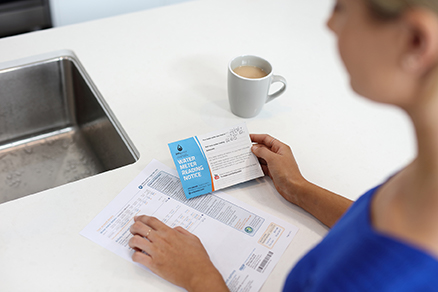
How to monitor your own water usage and detect hidden leaks early
- Regularly read and check your own water meter. We recommend every two weeks when you take your bins out.
- Write down the meter reading in kilolitres (black numbers only).
- Enter your meter reading online at My Usage Tracker which is available online at My Account.
- Any sudden increases in water usage could indicate a hidden leak. If you have any concerns that there may be water leaking, either before or after the meter, please read more about checking for leaks.
Please note: unusually spinning numbers on your water meter (when you aren't using any water inside your property) could also indicate a potential hidden leak.
As the property owner, you are responsible for monitoring and maintaining all of the plumbing pipework and fittings on your private property (including the pipe running from the water meter to your residence, and any internal plumbing within your residence). If a leak occurs in any pipe on your property, you are responsible for having the leak fixed and for the cost of the water.
How to read your meter and check for water leaks
Different types of water meters
There are different types of water meters across the Unitywater region. The black numbers on your water meter represent kilolitres (kL). One kilolitre (kL) equals 1000 litres (L). We use the black numbers to calculate the water usage on your bill. Below are some examples of common water meters:
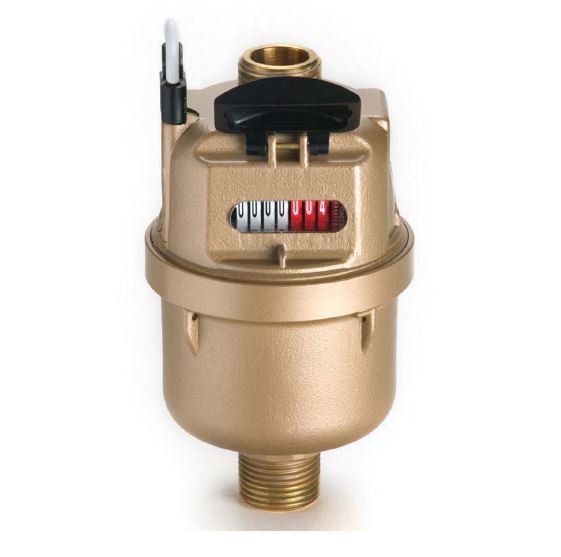
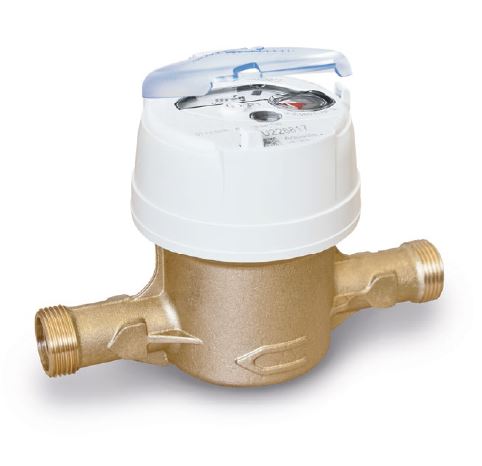
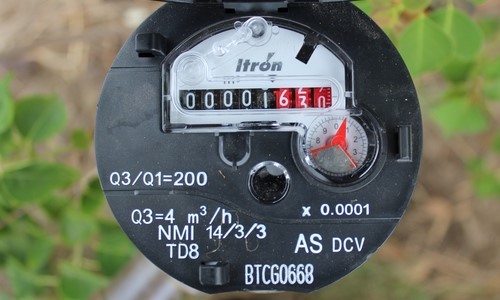
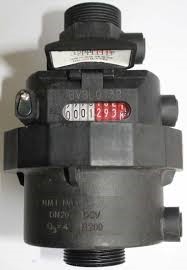
Elster V100 water meter Itron water meter Itron TD8 5 dial water meter GVT water meter
Meter reading FAQs
Your meter is usually found out the front of your residence, near the front border of your property. It could be inside a meter box or it may be above ground.
The black numbers on your water meter represent kilolitres (kL). One kilolitre (kL) equals 1000 litres (L). This is the unit of measurement our meter readers record as your meter reading. We then use this reading to calculate your bill. The white numbers on the red dials represent litres.
If you live or work in a unit complex, multiple properties may share one main meter with the usage divided between all the units at the property based on a 'property share percentage' (or lot entitlement). This is advised to us by the Department of Natural Resources and Mines (DNRM) and is detailed on the property’s account. Unitywater does not decide this share percentage. If you have any questions, please contact your Body Corporate.
We read your water meter quarterly (i.e. every three months or roughly 90 days). The number of days between meter reads can differ due to the fact that we may not be able to read your meter on exactly the same dates in each quarter.
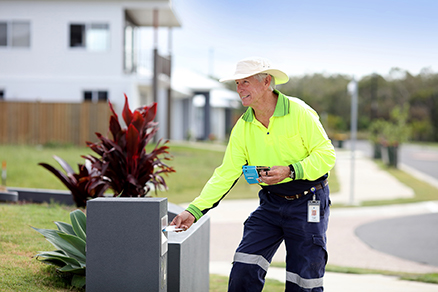
You should receive a blue Water Meter Reading Notice (PDF) in your letterbox advising you of the date your meter was read and meter reading number.
We recommend you take a meter reading on the same day you receive your Water Meter Reading Notice to confirm the reading on the notice and on your next bill are the same.
Keeping a record of your own meter readings is always useful as occasionally meter readers are unable to leave a card due to bad weather, or the notice could get caught up and thrown out in the junk mail.
.jpg?hash=C1420567171E62D07F0D8C8F80FD43300A2CED70&h=200&w=300&la=en)
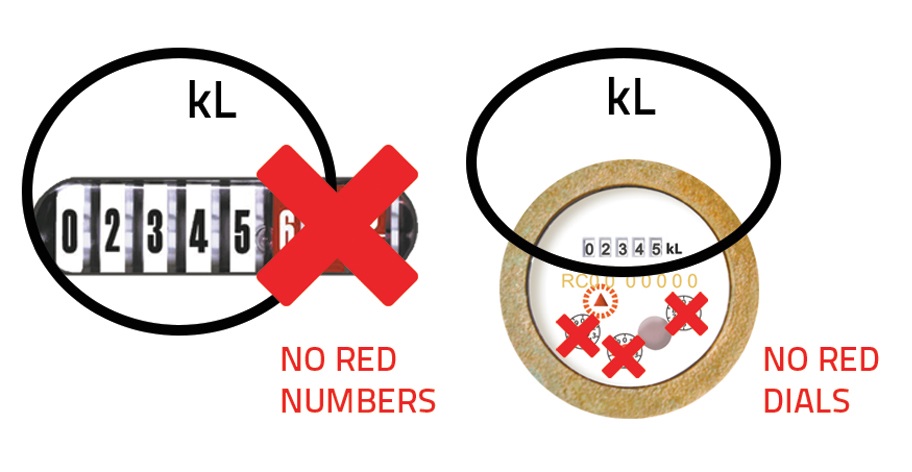
You normally receive you bill within a few days of your meter being read, but it can take up to 10 days or sometimes longer if you live in a unit complex. We need this time to audit all meter readings for accuracy. In this audit process, we compare the new reading with previous readings to ensure it is in line with previous usage patterns – all to make sure we are billing you correctly. If the reading seems too high or too low, compared with previous readings, we may reschedule a second reading to double check it is correct.
We are unable to notify customers of the exact dates of future meter readings (for example, for tenant billing purposes). However, we do advise an approximate date of the next meter reading. This is found on page 1 of your bill, along with the bill number and billing period information.
We also cannot accept keys to properties or gates (to allow meter readers access). Please contact us on 1300 086 489 if access to your water meter is restricted.
If we were unable to access your meter, we leave a red 'Urgent - Water Meter Not Read' Notice (PDF 26KB) in your letterbox advising you that we will attempt to read your meter a second time in the next few days. If we are unsuccessful in reading your meter again, the water usage on your next bill will be estimated based on previous actual water meter readings.
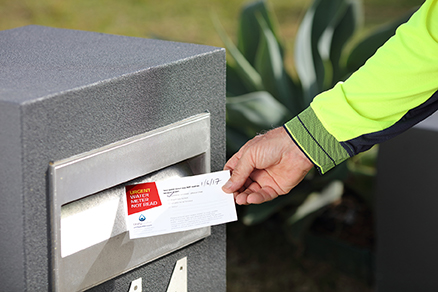
Unitywater endeavours to read every meter during our scheduled meter reading periods. If we cannot take a meter read on the scheduled day we will estimate the read.
Estimates are done where:
-
the meter is inaccessible (i.e. located behind locked gate, dog on premises),
-
the meter is damaged and dials are not readable;
-
the meter has stopped working and is not recording water passing through the meter, and
-
the meter cannot be located.
When we estimate it is based on:
-
the property's previous usage pattern;
-
an actual meter reading is scheduled for the next billing period and will be obtained where possible. The bill then 'catches up' using the actual read to ensure the customer has only been billed for what they have used.
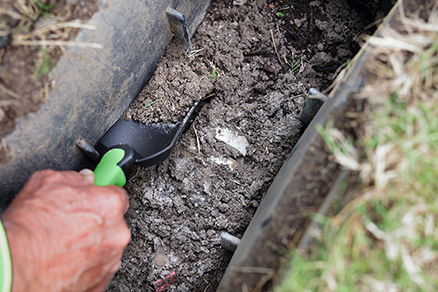
It is possible to install individual water meters, rather than having one main water meter, to existing buildings or unit complexes.
The Body Corporate must apply on behalf of the owners and all owners must give their consent. The installation will be at the cost of the owners or the Body Corporate.
For more about the process, fact sheets and application forms, please read the Sub-metering information kit (PDF 1.9MB)
Once you are ready to proceed, your plumber can find all the information they need in the sub-metering for plumbers section.
Note: sub-metering became mandatory for all unit complex developments built after 1 January 2008.
Sometimes you will receive a Meter Reading Notice and then see that your meter box is full of dirt. Our meter readers can read your meter if the meter box full of dry dirt. They simply move the dirt aside so they can read the dials on your meter and then put the dirt back into the meter box.
However if the dirt is wet, hard or compacted and it cannot be removed by the meter reader, a notice will be left in your letterbox to advise that we couldn't read your meter. Please make sure your meter box is accessible and well maintained, removing any dirt or other obstructions, so we can bill you correctly and on time.
Our meter readers do not leave the removed dirt on your lawn or garden beside the meter, as they are required to leave the area as they found it.
During certain times of the year, Australian native bees may colonise Unitywater meter boxes. While these bees provide low risk to yourself and our meter readers, they can impede on our ability to read the meter. If you have a colony in your meter box, please google and call a Native bee re-locator or removalist to attend and relocate the colony, so we can help protect the native bee population.
If, however, you have a wasps nest in your meter box, please remove the nest yourself or have it removed by professionals if you feel more comfortable with this.
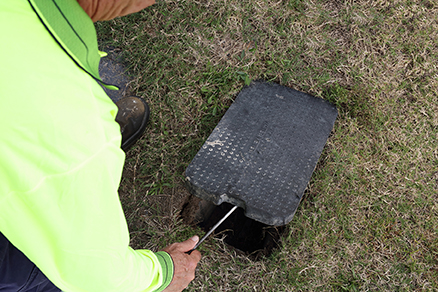
Meter reader opening the water meter lid
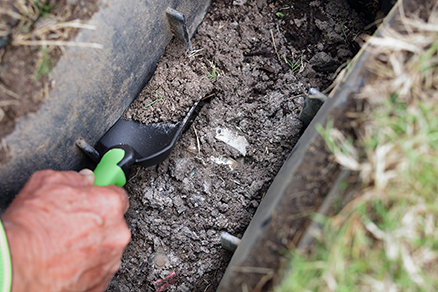
Meter reader clearing the dirt from the meter
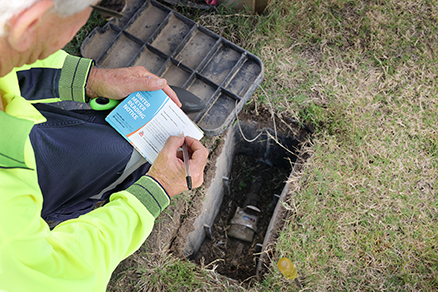
Meter reader writing down the reading
